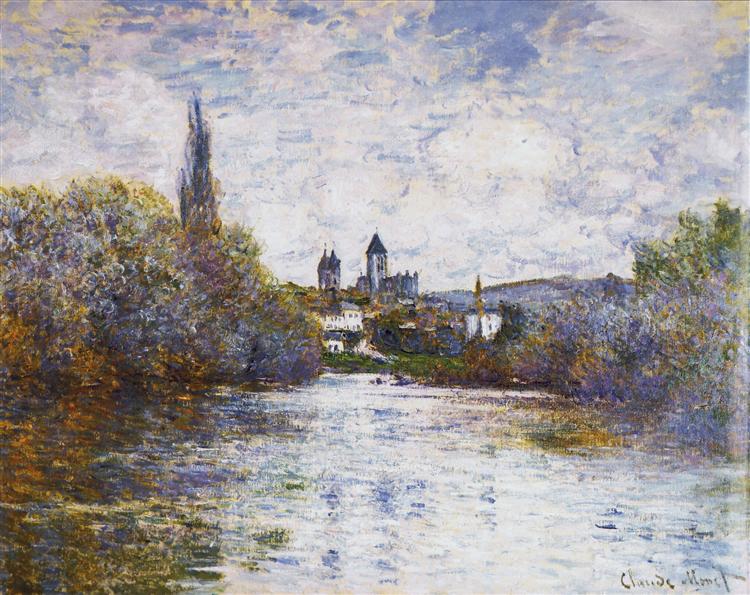Beschrijving
The painting "Vetheuil - The Little Arm of the Seine", created by Claude Monet in 1880, is presented as a masterpiece of Impressionism, an artistic movement that sought to capture the essence of the moment through light and color. In this work, Monet moves away from traditional narrative representation and opts for an exploration of the atmosphere and natural landscape, revealing his deep connection with nature and his surroundings in Vetheuil, a small town located on the banks of the Seine, where the artist spent a significant amount of time.
The composition is dominated by the stunning view of the Seine, whose waters meander across the canvas, with gentle ripples reflecting the hues of the sky. True to his technique, Monet employs quick, loose brushstrokes that allow the colours to blend together, creating a sense of movement and fluidity. The use of shades of blue in the water is complemented by vibrant greens in the vegetation, while the clouds and sky blend into a soft spectrum of greys and whites, suggesting both daylight and the influence of the changing atmosphere. This experimental approach to colour creates an almost poetic feel, blurring the lines between natural elements and giving the viewer an immersive visual experience.
Looking at the work, one can notice a few structures that loom along the riverbank, which seem to blend in with the surrounding landscape. These constructions are not mere architectural references, but serve to anchor the painting in a particular context, offering a harmonious contrast to the lush nature that surrounds it. The presence of the houses and trees also suggests human life and its coexistence with the landscape, a recurring theme in the work of Monet, who was often drawn to the intersection between the natural and the built.
Unlike his other works which often include characters, in Vetheuil - The Little Arm of the Seine the human figure seems absent, signalling a return to the purity of landscape over narrative. This absence can be interpreted as Monet's attempt to capture the solitude and serenity of nature, a sentiment which resonated increasingly in his work towards the end of the 19th century.
Monet created this painting during a period of innovations in his style, where his focus was on how light interacts with color at various times of the day. The choice of Vetheuil is not accidental; this location had become a refuge for Monet and his family, which infuses the work with a sense of intimacy and belonging. It would be in this location that Monet would also be encouraged to experiment and explore recurring themes in his career, such as the series of landscapes that would shift their focus to light and color during different times and seasons of the year.
Monet’s connection to the landscape of Vetheuil is therefore multifaceted. Through this painting, he invites the viewer to reflect on the relationship between humans and their environment, prompting a consideration of our perception of nature. In its quest to depict the ephemeral and the transitory, Vetheuil – The Little Arm of the Seine stands as a testament to Monet’s legacy in Impressionism, a space where the transience of human experience meets the eternity of the landscape. This work not only captures a moment in time, but also encapsulates a way of seeing the world that continues to resonate in contemporary art.
KUADROS ©, a famous painting on your wall.
Hand-made oil painting reproductions, with the quality of professional artists and the distinctive seal of KUADROS ©.
Painting reproduction service with satisfaction guarantee. If you are not completely satisfied with the replica of your painting, we will refund 100% of your money.

